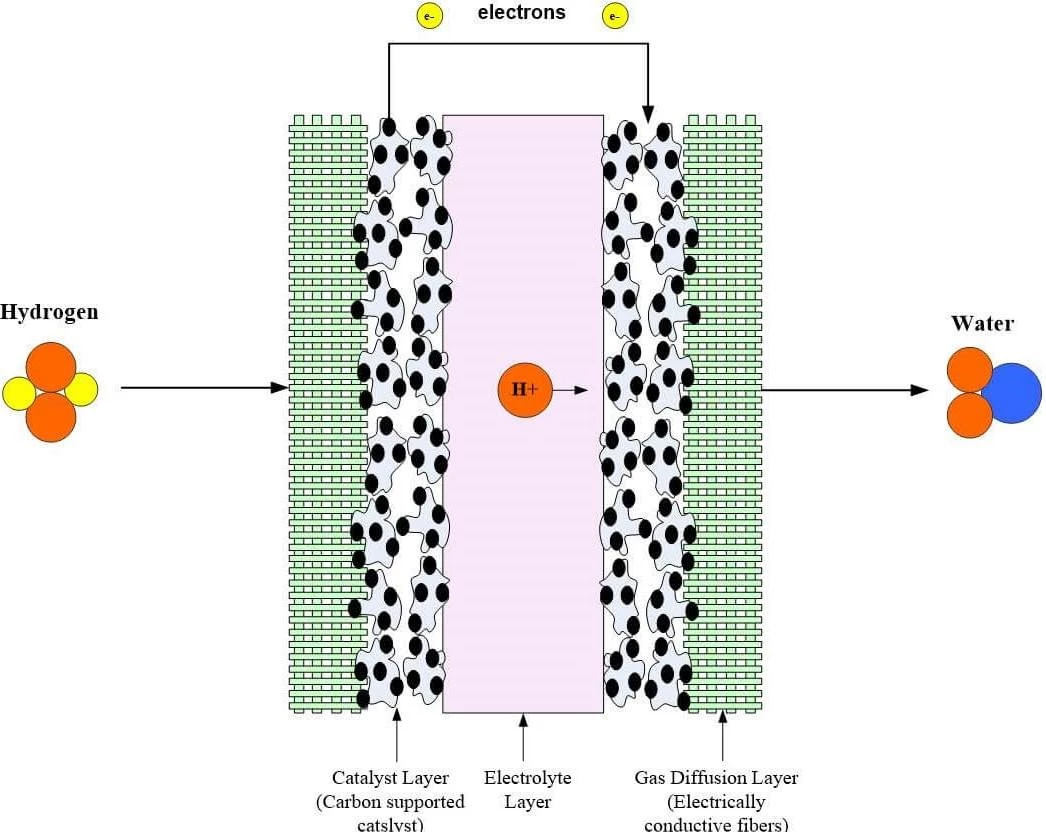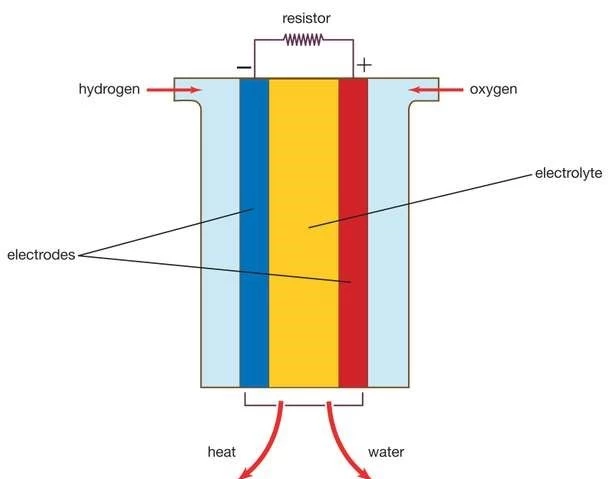Fuel Cells
Fuel Cells
What is a Fuel Cell?
An electrochemical device that transforms chemical energy from the reactants into electricity and heat is known as a fuel cell. It comprises an electrolyte layer in contact with a porous anode and cathode on either side. An outline of a fuel cell with reactants and products and the ion conduction stream direction through the cell is depicted below.

When it comes to the standard fuel cell, gaseous fuels are fused consistently to the anode (negative terminal). In contrast, an oxidant, which is oxygen from the air, is combined always to the cathode (positive terminal). Electrochemical reactions happen at the electrodes to deliver an electric flow.
Advantages of Fuel Cells
Listed below are some benefits of fuel cell system:
- A profound scalable structure.
- High working productivity that isn't a function of framework size.
- Several sorts of potential fuel sources are accessible.
- Prompt revive capacity when contrasted with batteries.
- Negligible greenhouse emissions.
- Fixed components in the fuel cell stack give, which gives dependable, vibration-free operation.
Limitations of Fuel Cells
Listed below are some of the limitations to all fuel cell frameworks.
• Fuel Reformation technology should be considered if unadulterated fuel isn't utilized.
• Cost-effective, mass-created unadulterated hydrogen stockpiling and delivery technology.
• Fuel cell execution may bit by bit decline after some time because of catalyst degradation and electrolyte harming if unadulterated fuel isn't utilized.
Principles of Fuel Cell Functioning
The components of a fuel cell (aggregate of cells) are similar to the parts of a battery. Every cell of a fuel cell framework has a coordinating pair of electrodes. Those electrodes are the anode, which supplies electrons, and the cathode, which assimilates electrons. The two electrodes must be drenched in and isolated by an electrolyte, which might be a fluid or a strong yet which should in either case exchange ions between the terminals to finish the science of the fuel cell system.
A fuel, for example, hydrogen, is provided to the anode, where it is oxidized, creating hydrogen ions and electrons. An oxidizer, for example, oxygen, is provided to the cathode, where the hydrogen ions from the anode ingest electrons from the last mentioned and respond with the oxygen to deliver water. The contrast between the separate energy levels at the electrodes (electromotive power) is the voltage per unit cell.
The quantity of electric flow accessible to the external circuit relies upon the concoction movement and measure of the substances provided as fuels. The current-forming process proceeds for whatever length of time that there is an inventory of reactants, for the terminals and electrolyte of a cell, unlike those in a standard battery, are intended to stay unaltered by chemical reaction.

A fuel cell is fundamentally an intricate framework. It must have characteristics to aid the movement of the fuel, siphons and blowers, fuel-stockpiling compartments, and an assortment of advanced sensors and controls with which to screen and alter the operation of the framework. The working ability and lifetime of every one of these framework configuration features may restrict the exhibition of the fuel cell.
As on account of other electrochemical frameworks, fuel cell operation is reliant on temperature. The chemical movement of the fuels and the estimation of the activity promoters, or catalysts, are diminished by low temperatures. High temperatures, then again, improve the movement factors; however, it may lessen the functioning lifetime of the electrodes, blowers, construction materials, and sensors. Each sort of fuel cell in this manner has a working temperature design extend, and a massive takeoff from this range is probably going to decrease both capacity and lifetime.
Energy Change Within Fuel Cell
A fuel cell, similar to a regular battery, is characteristically a high-effectiveness device. The high effectiveness implies substantially less fuel and a small storage holder are required for a fixed energy prerequisite. It is not like internal-combustion machines, where a fuel is scorched, and gas is expanded to accomplish work, the fuel cell changes over chemical energy into electrical energy. Due to this principle feature, fuel cells may change over fuels to useful energy at proficiency as high as 60 per cent. In comparison, the internal-combustion motor is restricted to efficiencies close to 40 per cent or less.
Fuel cells are a great source of power supply for space missions of constrained duration and for different situations where fuel is over the top expensive and hard to supply. They additionally emanate no poisonous gases, for example, nitrogen dioxide and produce practically no clamor during operation, making them suitable for nearby metropolitan electricity-generation stations.
A fuel cell can operate reversibly. A hydrogen-oxygen cell that produces water as an end-product can be made to regenerate hydrogen and oxygen. Such a re-forming fuel cell involves a revision of cathode configuration as well as the introduction of unique methods for isolating the product gases. In the end, power modules including this sort of high-proficiency fuel cell, utilized in conjunction with enormous varieties of warm gatherers for solar-powered warming or other solar-based energy frameworks, might be used to keep energy-cycle costs lower in longer-lived gear. Significant car organizations and electrical-apparatus fabricating organizations worldwide have reported their intention to create or utilize fuel cells industrially in the coming years.


Similar Questions
Knowledge Check
The advantage of methane fuel cells over internal combusion engines (ICEs) that burn methane include which of the following?
(P) Methane fuel cells are less polluting.
(Q) Methane fuel cells are more efficient.
(R ) Methane fuel cells are less expensive.AP onlyBP and Q onlyCQ and R onlyDP, Q and RFuel cell is an electrical cell which converts chemical energy into electrical energy. The most successful fuel cell is H2−O2 fuel cell, which is known as Bacon cell. It had been used to fulfil the electric power supply required in Appolo mission. This fuel cell is pollution free.
Fuel cells are preferred to other energy producing devices in space because ofAhigh efficiencyBpollution free natureCless weightDall of theseFuel cell involves following reaction (s) :
AO2(g)+2H2O(l)+4e−→4OH−(aq.) (at cathode)BO2(g)+2H2O(l)+4e−→4OH−(aq.) (at anode)C2H2(g)+4OH−(aq.)→4H2O(l)+4e− (at anode)D2H2(g)+4OH−(aq.)→4H2O(l)+4e− (at cathode)
What is a fuel cell ? Give advantages of a fuel cell.
View SolutionFuel cell is an electrical cell which converts chemical energy into electrical energy. The most successful fuel cell is H2−O2 fuel cell, which is known as Bacon cell. It had been used to fulfil the electric power supply required in Appolo mission. This fuel cell is pollution free.
The fuel used in the cell used in Appolo mission was
View SolutionFuel cell is an electrical cell which converts chemical energy into electrical energy. The most successful fuel cell is H2−O2 fuel cell, which is known as Bacon cell. It had been used to fulfil the electric power supply required in Appolo mission. This fuel cell is pollution free.
The cell used in Appolo mission was
View SolutionMark the incorrect statement (s) for fuel cell
View SolutionEMF of an H2−O2 fuel cell
View Solution
